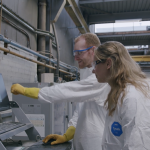Sector - Environment
Construction in the UK – building resilience

On 1 October 2021, it became mandatory for all companies bidding for government contracts worth more than £5m a year to commit to achieving net zero emissions by 2050. Here, Andy Scothern, founder of eCommonSense an ECI Software Solutions company, and BMBI panellist, talks about the construction industry’s efforts towards net zero, supply chain issues, and how it can become more resilient to crisis.
What challenges is the supply chain experiencing currently?
Combining the highest inflation rates in 40 years with the challenges created by Brexit, the COVID-19 pandemic and the conflict in Ukraine, the past three years have created the perfect storm for supply chain problems. Imports and exports have been severely delayed and the price of raw materials has skyrocketed. These problems are particularly challenging for SMEs who have smaller cash reserves to fall back on.
Today, supply chains are often international, and whilst this has obvious benefits, it also carries risk. Their scales and intricacies make them more susceptible to disruptions and delays. Closer to home, the volatility of the situation means that efforts to react and recover from crises are often still underway by the time the next problem hits a business.
How does this affect net zero ambitions?
Understandably, the aforementioned problems often require an immediate response from industry leaders, as they attempt to maintain stability. As a result, the bigger issues such as global warming and the climate crisis are frequently side-stepped, being labelled as less urgent.
This has created an almost habitual practice of prioritising other areas over achieving the net zero target.
In May 2019, the UK Parliament declared an ‘environment and climate change emergency’, with the government committing to a 2050 net zero emissions target a month later. With a clear understanding that we must all make the necessary changes to collectively achieve the net zero target, many eyes fall upon the building and construction sector – an industry that has a big part to play in reducing resource consumption and the high levels of carbon emissions.
Are net zero ambitions achievable in the sector and what needs to happen to achieve them?
From 1 October 2021, it became mandatory for all organisations bidding for government contracts worth more than £5m a year to commit to achieving net zero emissions by 2050, taking into account all business travel, employee commuting, transportation, distribution and waste production. This is a positive first step, but there are a number of other issues that need to be addressed to help the sector achieve its net zero ambitions.
With experts estimating that the current global construction levels equate to a city the size of Paris being built every week, it’s unsurprising that the construction and built environment sectors account for 38% of worldwide carbon emission.
Even though they are included in the government regulations set out in 2021, unfortunately, shipping and air freight contributions are often excluded from industry data. They are deemed “international emissions” and therefore excluded from the total equation. This needs to change as they play a key role in the supply chain.
Once we begin delivering accurate information in a transparent manner, we can then start to analyse a true picture of the industry’s impact on the environment and begin to act accordingly. New efforts must be made to find the true measure of emissions at every stage of the supply chain.
Following this, behavioural changes can start to be implemented from the top down, with policies and procedures in place to ensure that businesses are taking the required steps towards achieving net zero. Here, construction can take a note from other industries, as the FCA has recently proposed imposing fines on businesses that are found to be greenwashing their practices.
As younger people gain more influence across the sector, we are likely to see a sea change in opinion, with this cohort arguably more environmentally conscious. Having grown up with constant news around climate change and the negative impacts of global warming, these individuals are likely to place net zero targets front and centre when it comes to making decisions.
What can construction do to improve the sustainability and resilience of the supply chain?
It was the eminent physicist Albert Einstein who was first quoted as saying “you cannot solve a problem with the same thinking that caused it”. The same may well be true for reaching net zero. The whole construction industry and those related to it, from builders’ merchants to manufacturers, should aim to improve their resilience with new thinking to reduce their carbon footprints.
Allowing business managers to maintain total visibility over supply chains and sales, specialist software helps to reduce the wider impact of major delays and crises. They can act as not only a way to recover from significant setbacks, like those being faced today, but to help futureproof and build the resilience needed in years to come.
The road ahead for the construction industry is certainly expected to be uneven and bumpy, with many necessary changes needing to be made in order to achieve net zero by 2050. Tackling the climate crisis as well as other existing industry challenges is no small task, but by deploying technology and making the most of industry-specific software, builders merchants will be in the best position to thrive in the future.
If you would like to read more stories like this, then please click here
Related Articles
More Environment Features
- Government correct to head off Climate and Nature Bill
7 Feb 25
The ‘Climate and Nature Private Members’ Bill’, seeks to set new legally binding targets for climate and nature.
- Biodiversity Net Gain Now in Force – What Does It Mean for You?
12 Jul 24
The UK has significantly advanced by implementing Mandatory Biodiversity Net Gain (BNG) in the ongoing effort to balance development with conservation.
- Building a sustainable built enviornment – On the path to Net Zero
5 Jan 24
How the sector can contribute to the transition to a net zero economy.





